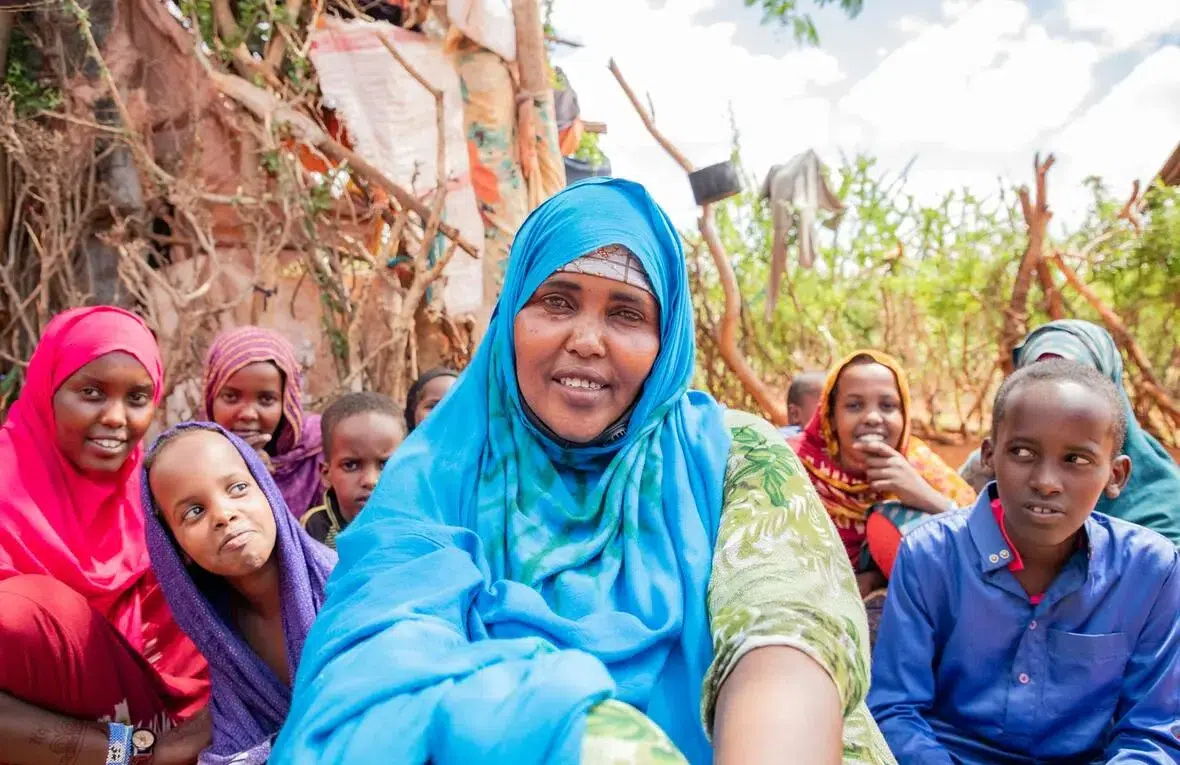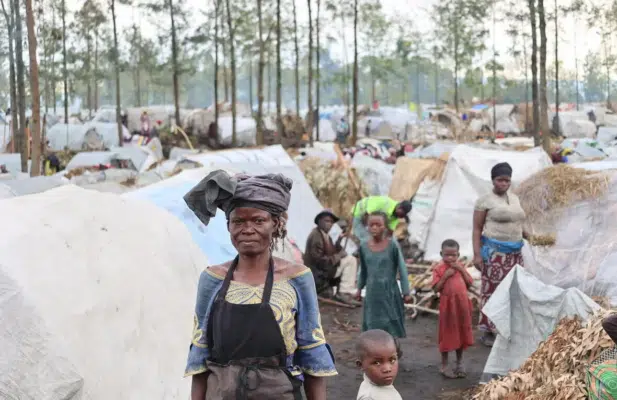
Hinda Mahdi and her children were among a first group of refugees relocated to the new Mirqaan settlement in Ethiopia’s Somali region. © UNHCR/Diana Diaz
After escaping deadly clashes to reach safety in Ethiopia, Hinda and her children have joined other refugees in a new site in Mirqaan where they can start over in safety.
Hinda Mahdi and her children flinch as the bus door slams shut behind them. They are the last family to board for the ride to Mirqaan, a new settlement in Ethiopia’s Somali region, allocated to house Somali refugees fleeing violence back home. The slamming door momentarily takes them back to the day in February when morning prayers were interrupted by gunshots and screams.
“It was like everyone was going crazy,” said the 30-year-old mother of nine. “Gunshots everywhere, all over my house.” Hinda’s neighbour, and her eight children were killed in the crossfire, while her own home was burned to the ground and her husband is still unaccounted for. “I don’t know if he’s alive or dead,” she said.
Hinda and her children joined a group fleeing the city of Laascaanood in Somalia’s Sool region to seek safety in neighbouring Ethiopia. Since the clashes began in mid-February, nearly 100,000 Somalis have crossed the border. Many are women and children, as well as the elderly and people with disabilities, who have arrived in an area hit by drought and with scarce resources.
Hinda and her children’s journey began with a three-hour walk before a truck carrying 54 other people picked them up and took them across the border. Once there, a passing driver suggested they go to Goob, a small town around 11 kilometres from the border where they could rent a small place to stay.
“It costs US$15 to rent this place each month. But without a job, all alone, I can’t afford it. I can’t do this alone,” Hinda said. She described the comfortable life they left behind in Laascaanood, with a steady income from a family butchery business and all her children attending school.
Reaching the most vulnerable
Since the beginning of the influx, UNHCR, the UN Refugee Agency, the Ethiopian Government’s Refugees and Returnees Service (RRS) and other humanitarian agencies have been rushing to support the new arrivals and deliver assistance to the most vulnerable, like 27-year-old Barbaqad Abdi Aden.
Although he was born with a disability, Barbaqad was studying computer science in Laascaanood and dreamed of one day becoming a teacher. When the clashes broke out, he heard gunshots outside his home.
“There were bombings and killings in broad daylight. Everyone started running to different places alone,” he said, describing how he became separated from his family. “It took me a week to reach the Ethiopia border. I waved my hand to a driver passing by who helped me.”
Barbaqad had a hard time integrating in the town of Goob where he was discriminated against due to his disability, so he stayed on the outskirts with some friends he reunited with in Ethiopia.
Over 84,000 Somali refugees have received food commodities provided by the World Food Programme (WFP), and those with the most urgent needs have also been given blankets and other essential items. But with more people arriving daily to escape the ongoing violence in their country, the needs continue to rise.
On 22 March, UNHCR together with other humanitarian partners launched a refugee response plan requesting US$116 million to meet the critical needs faced by refugees and host communities in this area.
Many refugees are being hosted by Ethiopian families in their homes, but the majority are staying in informal sites, overcrowded shelters, medical centres and schools, or are sleeping outdoors.
In response, the Government of Ethiopia allocated 400 hectares of land to establish a settlement where newly arrived refugees can choose to move. UNHCR and partners have been developing the site and, with the support of IOM, the International Organization for Migration, began in early April relocating hundreds of refugees a day.
Support for refugees and their hosts
Following the bus journey, Hinda and her family were among the first group of Somali refugees to arrive in Mirqaan. She and her children were allocated a family tent and provided with access to water. She was registered to receive much-needed aid and is now one of the community leaders helping to set up the site.
“I am so happy. I feel better about going to Mirqaan,” said Hinda, who was running out of money and options in Goob. Looking ahead, she is hopeful that her children can continue their studies. “My children were in school [in Somalia] and I expect they can continue learning here. My dream is for my children to get a good education.
UNHCR is working with local authorities in Mirqaan, as well as other locations across the Doolo zone where refugees wish to remain, to help them integrate and live harmoniously with local host communities. Here, UNHCR and other partners are assessing needs to ensure any support will contribute to the wellbeing of both refugees and their hosts. So far, UNHCR has been able to provide medicine and water to the Mirqaan health centre to support their response to both communities. Plans are underway to expand support to other areas generously hosting refugees.
“The Government of Ethiopia, UNHCR and partners are doing their utmost to facilitate the inclusion of refugees in local communities and have them share services with our support,” explained Hugues Bissot, UNHCR’s emergency coordinator. “We are working with partners to improve those services by increasing the capacity of schools and health centres so that both refugees and host communities can benefit.”
Originally published by UNHCR on 11 May 2023.





